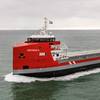Risky Business
Underwriting your newbuild program is only one half of the sea passage. That’s because the construction phase is fraught with danger.
Congratulations! You’ve run the due-diligence/underwriting gauntlet successfully and now you have your lender’s credit approval in hand. You are satisfied with the terms and conditions of the loan or lease and the lender or lessor is happy with you. Don’t celebrate quite yet, though. You are only about half of the way home.
Everyone knows that new and used tugs and barges, OSVs, crew boats or ferries don’t come cheap. It’s a double edged sword. On the one hand, the cost of entry into the commercial marine industry is one of the greatest limiting factors to new players/competitors gaining entrance; on the other, it’s just plain expensive. That high cost preserves the value of the businesses that operate in the industry as well as the assets themselves. But just as with any major construction project, whether it is a commercial vessel, an airliner or a locomotive, finding the source of funding for new equipment before it is in service and providing a revenue stream (and thus debt coverage) can be a significant challenge.
Funding
So you have your shipyard slot and have your construction contract in hand, you have agreed on the schedule of progress payments from deposit to delivery. Now you’re going to have to figure out where the money is coming from to finance the construction of the vessel. Unless it’s sitting in your bank account, you’re going to need interim or construction phase financing to get you to the completed vessel’s delivery and on to your permanent loan.
If you are sufficiently capitalized you can handle payments from your own cash flow or other cash resources. But with each successive progress payment with no revenue being generated by the vessel under construction, the deep, dark hole keeps getting deeper and darker as you go along. Your lender should anticipate that during the new construction or refit process, the ability of the vessel being financed to generate income is non-existent.
Your lender also knows that the period of highest risk in the transaction is during the construction or refit period both from your loss of income standpoint, and that of a dreaded shipyard default or bankruptcy. Ideally, if the shipyard can self-fund the construction or have a construction revolver or other source of funding, that is for lender and borrower, the best of all worlds.
If your shipyard cannot fund the construction, they, you and your lender must agree on construction phase funding to move the project forward. It is in your best interest, as you remain the party responsible for construction debt, to choose your shipyard wisely and work with your lender to perform due diligence on the shipyard’s financial condition. In the process of approving a shipyard for construction finance, your lender will request a financial package from them similar to that which was requested from you including, but not limited to:
• Construction Contract with Draw Schedule;
• Provision for Builder’s Risk and other applicable insurances;
• Three previous year’s financial statements;
• Current and historic (previous year’s) quarterly financial statements;
• Trade and Bank References;
• Current cash flow with A/P and A/R;
• Work-in-Progress;
• Personal financial statements of owners (occasionally).
After the receipt of the shipyard’s financials, the lender will approve the shipyard, decline to provide the interim financing and provide permanent financing only, or require a construction, performance or other type of surety bond. The bonding option can be the most costly option for both the borrower and/or the shipyard. However, such bonds provide financial security and assurance of the completion of a construction project by insuring the borrower (and lender) that the shipyard will perform the work and pay the cost of materials, suppliers, subcontractors and other labor; albeit at a significant cost.
Interestingly, a shipbuilding contract is not covered by maritime/admiralty law. It is a contract made on land to be performed on land. A completed, launched and fully fitted-out vessel is only considered a vessel to function under maritime law after full completion of its construction and delivery. Once completed, it then is subject to maritime law which includes flag status, documentation, filing liens and the perfection of interest via a ship’s mortgage.
Approaching the Sea Buoy
Some interim protections for the borrower and lender can be had state-to-state through the filing of UCC-1 claim of ownership of assets purchased for and/or supplied by the borrower and lender. Most significant of these items may be engines, generators, transmissions, steel, electronics or other high cost components. Given that the rights of the lender, borrower and shipyard can be equitably preserved, we are heading down the home stretch. Now; progress payments, per contractual obligations, are scheduled and paid.
During the negotiation of the shipbuilding contract, certain milestones in construction, when reached, trigger the payment to the shipbuilder of a progress payment. The payments, when made to the shipbuilder by the lender, begin to accrue interest for the borrower. Depending on the comfort of the lender, these interest payments may be billed to and paid by the borrower on a monthly basis, or capitalized during construction and added into the overall loan amount provided by the lender.
Typical progress payments may occur when the contract is signed, the keel is laid, steel is delivered, plating of the hull occurs, engines and running gear are installed, deck is completed, superstructure is built, ship’s services are installed, interior is finished, vessel is painted and finally launched, sea trialed and accepted by the new owner. The completions of certain milestones are usually verified by inspection by a surveyor commissioned by the lender or the tending of delivery documents for large components like engines, drives and transmissions. Prior to payment, the borrower issues notification to the lender agreeing with the progress made and authorizing the payment to the shipbuilder. Normally, if the percentage of advance has been agreed upon by the borrower and lender, the borrower will pay the first progress payments up to the amount specified as the borrower’s down payment.
Risky Business
Construction phase finance is fraught with danger. It is truly a risky business. Both borrowers and shipbuilders alike may experience financial or other business calamities that can make the completion of the build impossible. It is not unheard of for a borrower and lender to move a vessel under construction to another yard from a yard in trouble, or contract another builder to complete the vessel under construction at great or increased cost, or at the last minute have to find another buyer for the vessel under construction. As such, few lenders will assume the jeopardy of the construction phase without also anticipating the financial reward of the permanent loan. No one wants to end up with an unfinished pile of steel rusting on a beach somewhere. And, it happens all too often.
Make vessel construction a less risky business. Consult your legal and financial experts to know where the hazards lie, and as Tom Cruise learned; don’t borrow your Dad’s Porsche 928.
(As published in the June 2013 edition of Marine News - www.marinelink.com)











